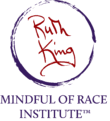In 2015, I gave a talk to a predominantly white Buddhist community. It was a heartfelt evening in which we explored the epidemic of violence that was infesting many of our communities near and far, and we discussed how to stay intimately present with an open heart.
After a thirty-minute silent meditation, I had everyone state their names. Then, after everyone finished, I offered a few names of people who were present in my mind but no longer with us: Tamir Rice, Michael Brown, Eric Garner, and others.
I then said to the group, “These are just a few of the names of unarmed African American men, women, and children killed by police over the past several months, and I’m Ruth King, their Mother.”
Today, of course, I would add the names of Breonna Taylor, George Floyd, Ahmaud Arbery, and so many names of Black dear ones and allies whose lives have been cut short by police brutality, domestic terrorism, and systemic racism.
Undoubtedly, one loss would be too many. And perhaps some of you reading these words have had experiences of such senseless loss or violence. To you, I offer compassion for continuing to heal.
For the many others, however, who have the option of turning away, I invite you — as I invited the practitioners that evening — to feel into the heartbreak of these losses with compassion. This is what compassion meditation might look like today: touching the raw reality that many of us chronically live with.
You might try this by contemplating questions like these in your meditation:
-
Suppose the common violence toward and killing of dark bodies were happening toward your own children or dear ones. How would you feel?
-
Imagine stepping into the skin of the mothers, fathers, sisters, brothers, children, or families of one of these men, women, or children. What do you experience in your body, mind, and heart? What feelings or thoughts arise?
-
How would you feel if there was no indictment of the police officers who killed your loved one under conditions when such an act could have been avoided?
-
Now imagine you are the mother or father, son or daughter of the police who did the killing. What do you experience in your body, mind, and heart?
-
How would you feel in mind, body, and heart if, after generations of peaceful protest and legal advocacy, innocent people from your community were still being killed and brutalized with such horrifying regularity?
-
Notice from your bodily sensations what actions feel urgent. How clear are you about taking those actions?
-
What are you feeling in your heart, body, and mind as you sit with this contemplation? Are you on fire? Numb? Sad? Indifferent? Angry?
Bearing witness to racial suffering without turning away is an opportunity to discover our humanity, our innate kinship. If we take on this practice, we begin to move through the world with more awareness and sensitivity. We begin to notice the pervasive depth of racial harm and injustice in our lives and throughout the world. We also feel the soreness and tenderness that comes with such awareness and notice the habitual ways our body and mind defend against it. And we feel compelled to work toward a world in which no one else experiences such pain again.
The purpose of this compassion reflection is to see clearly and experience directly racial suffering. It requires us to feel into the experiences of those who are suffering without turning away, and offer our wish that everyone, without exception, be free from pain and suffering.
Yes, the burden of such suffering can be heavy on the body, heart, and mind. But compassion practice actually serves as an anticoagulant to those burdens. As we cultivate more and more compassion, we experience more inner circulation — more flow, lightness, and openness.
In fact, when we cultivate compassion in our meditation practice and throughout the day, it often leads to some remarkable changes.
We let go by softening the tightness in our own heart and mind.
We recognize and allow our own ignorance and innocence and those of others, and we nurture both the heartbreak of racial suffering and its release.
We experience more space to soften, to forgive, and to receive all that life offers.
We begin to realize there is more love in our heart than anything else — we’re just not in the habit of relying on it.
We discover that we can do more than beat up others and ourselves for how things are.
We begin to recognize ourselves in the suffering of others, even in its grand disguises.
In my talk at the meditation center, I ended with this: “The next time you hear of a brown person being killed by anyone, stay present and say to yourself: ‘Oh my, another one of Ruth’s children has been killed.’ Then check in with your own heart to determine the appropriate response.”
An excerpt from Mindful of Race: Transforming Racism from the Inside Out. Printed with permission by Ten Percent Happier, September 29, 2020.

